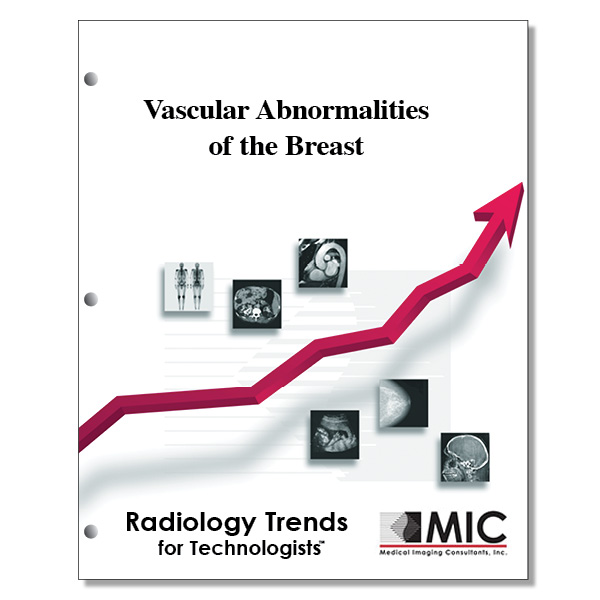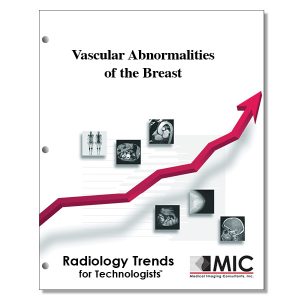

Vascular Abnormalities of the Breast
Arterial and venous disorders as well as benign and malignant vascular masses are examined with mammography, MRI, and ultrasound.
Course ID: Q00355 Category: Radiology Trends for Technologists Modalities: Mammography, MRI, Nuclear Medicine, Sonography3.25 |
Satisfaction Guarantee |
$34.00
- Targeted CE
- Outline
- Objectives
Targeted CE per ARRT’s Discipline, Category, and Subcategory classification:
Breast Sonography: 3.25
Procedures: 3.25
Anatomy and Physiology: 1.25
Pathology: 2.00
Mammography: 3.25
Procedures: 3.25
Anatomy, Physiology, and Pathology: 3.25
Magnetic Resonance Imaging: 3.25
Procedures: 3.25
Body: 3.25
Nuclear Medicine Technology: 3.25
Procedures: 3.25
Endocrine and Oncology Procedures: 3.25
Registered Radiologist Assistant: 3.25
Procedures: 3.25
Thoracic Section: 3.25
Sonography: 3.25
Procedures: 3.25
Superficial Structures and Other Sonographic Procedures: 3.25
Radiation Therapy: 3.25
Procedures: 3.25
Treatment Sites and Tumors: 3.25
Outline
- Introduction
- Normal Breast Arterial, Venous, and Lymphatic Anatomy
- Normal Imaging Appearance of Breast Vasculature
- Arterial Disorders of the Breast
- Atherosclerosis
- True and False Breast Aneurysms
- Venous Disorders of the Breast
- Collateral Venous Flow in the Breast
- Congestive Heart Failure
- Superficial Thrombophlebitis
- Breast Varix
- Benign and Malignant Vascular Breast Masses
- Benign Vascular Breast Masses
- Hemangioma
- Lymphangioma
- Angiolipoma
- Malignant Vascular Breast Masses
- Angiosarcoma
- Hemangiopericytoma
- Devascularized Breast Masses
- Infarcted Lactating Adenoma
- Infarcted Giant Juvenile Fibroadenoma
- Pathologic Mimics of Vascular Masses
- Pseudoangiomatous Stromal Hyperplasia
- Phyllodes Tumor
- Benign Vascular Breast Masses
- Conclusions
Objectives
Upon completion of this course, students will:
- identify the breast gland type
- know the breast arterial supply
- identify the most dominant artery supplying the breast vasculature
- identify which arteries supply the medial and central parenchyma of the breast
- know venous anatomy of the breast
- be familiar with the superficial venous network in the breast
- identify factors that influence normal increases in blood supply to the breast
- recognize factors that can influence differentiation of veins and arteries during imaging
- recognize spectral Doppler analysis of a normal breast artery
- clarify how breast vessels are identified and differentiated on ultrasound
- review how compression maneuvers on ultrasound can help identify pathologies
- consider how resistive indices are used during breast imaging
- understand the MIP post-processing technique
- recognize the significance of asymmetrical breast vascularity
- realize the need for a good understanding and assessment of normal and pathologic breast vasculature
- describe the appearance of atherosclerotic vessels when seen on mammography
- identify potential risk factors that should be considered when atherosclerotic calcifications are encountered
- discuss breast aneurysms and pseudoaneurysms
- realize the significance of bilaterally enlarged breast veins
- know the significance of unilateral superficial breast vein dilatation
- recognize the vascular characteristics typically seen in the breast of a patient with congestive heart failure (CHF)
- identify the breast pathologies related to unilateral breast edema
- discuss Mondor disease of the breast
- explain the pitfalls of mammographic imaging of a breast varix
- identify potential causes of bilateral breast varices
- gain knowledge of the most common types of benign vascular tumors of the breast
- distinguish classifications of breast hemangiomas
- examine the reliable distinguishing features of a breast hemangioma
- understand the most common locations in the breast where lymphangiomas typically grow
- characterize the appearance of color flow Doppler in lymphangiomas
- identify other breast abnormalities that breast lymphangiomas might mimic
- identify other breast abnormalities that breast angiolipomas can mimic on ultrasound
- define breast angiosarcomas
- classify breast angiosarcomas
- distinguish the most common location for development of angiosarcomas
- know what histopathologic diagnoses can resemble a hemangiopericytoma
- identify types of devascularized breast masses
- explain when infarcted lactating adenomas occur
- know the most common breast masses found in girls
- explain pseudoangiomatous stromal hyperplasia (PASH)
- recognize the mammographic, sonographic, and MR features of vascular breast masses
- know what other breast abnormalities the histologic appearance of PASH can resemble
- realize what percentage of phyllodes tumors will demonstrate regions of malignant degeneration
- know what percentage of phyllodes tumors are true sarcomas that can metastasize hematogenously
- distinguish what patient age group is most affected by phyllodes tumors
